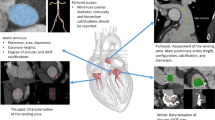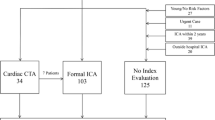Abstract
Although pericardial effusion (PE) early after transcatheter aortic valve implantation (TAVI) has been reported in few registries, late PE at follow-up remains unexplored. Particularly, after transapical TAVI, diagnosis of PE with transthoracic echocardiography (TTE) may be challenging. The present evaluation assessed the incidence of PE early after TAVI and at 1 month follow-up using TTE and multi-detector computed tomography (MDCT). The agreement between TTE and MDCT to diagnose the presence and severity of PE at 1 month follow-up was evaluated. Overall 293 patients undergoing TAVI were included. Pre-discharge TTE was performed in all patients. At 1 month, repeat TTE was performed in 234 patients and additional MDCT evaluation in 143 patients. Pre-discharge small and moderate PE was observed in 74.1 and 4.1 % of patients, respectively, whereas significant PE was diagnosed in 8 (2.7 %) patients without differences between procedural access: 1.6 versus 3.6 % for transfemoral and transapical respectively, p = 0.474. At 1 month new-onset moderate PE was noted in 6 (2.5 %) patients all of who underwent transapical TAVI. MDCT and TTE disagreed on the grade of PE in 38 patients. Importantly, one patient with small PE on TTE was considered having moderate PE and two patients with small and moderate PE were considered having large PE. Also, two patients with moderate PE on echocardiography were considered small PE on MDCT. In conclusions, significant PE early after TAVI is infrequent. The prevalence of small and moderate PE remains stable at 1 month follow-up. MDCT refines the diagnosis of significant PE.


Similar content being viewed by others

References
Ikaheimo MJ, Huikuri HV, Airaksinen KE et al (1988) Pericardial effusion after cardiac surgery: incidence, relation to the type of surgery, antithrombotic therapy, and early coronary bypass graft patency. Am Heart J 116:97–102
Tsang TS, Barnes ME, Hayes SN et al (1999) Clinical and echocardiographic characteristics of significant pericardial effusions following cardiothoracic surgery and outcomes of echo-guided pericardiocentesis for management: Mayo clinic experience, 1979–1998. Chest 116:322–331
Kuvin JT, Harati NA, Pandian NG, Bojar RM, Khabbaz KR (2002) Postoperative cardiac tamponade in the modern surgical era. Ann Thorac Surg 74:1148–1153
Lange R, Bleiziffer S, Piazza N et al (2011) Incidence and treatment of procedural cardiovascular complications associated with trans-arterial and trans-apical interventional aortic valve implantation in 412 consecutive patients. Eur J Cardiothorac Surg 40:1105–1113
Di Mario C, Eltchaninoff H, Moat N et al (2013) The 2011–12 pilot european sentinel registry of transcatheter aortic valve implantation: in-hospital results in 4,571 patients. EuroIntervention 22:1362–1367
Dill KE, George E, Abbara S et al (2013) ACR appropriateness criteria imaging for transcatheter aortic valve replacement. Am Coll Radiol 10:957–965
Leibowitz D, Perlman G, Planer D, Gilon D, Berman P, Bogot N (2011) Quantification of pericardial effusions by echocardiography and computed tomography. Am J Cardiol 107:331–335
Groth M, Regier M, Muellerleile K, Bannas P, Adam G, Henes FO (2012) A new formula for rapid assessment of pericardial effusion volume by computed tomography. Acad Radiol 19:718–722
Klein AL, Abbara S, Agler DA et al (2013) American society of echocardiography clinical recommendations for multimodality cardiovascular imaging of patients with pericardial disease: endorsed by the society for cardiovascular magnetic resonance and society of cardiovascular computed tomography. J Am Soc Echocardiogr 26:965–1012
Katsanos S, Ewe SH, Debonnaire P et al (2013) Multidetector row computed tomography parameters associated with paravalvular regurgitation after transcatheter aortic valve implantation. Am J Cardiol 112:1800–1806
Ewe SH, Delgado V, Ng AC et al (2011) Outcomes after transcatheter aortic valve implantation: transfemoral versus transapical approach. Ann Thorac Surg 92:1244–1251
Grube E, Laborde JC, Gerckens U et al (2006) Percutaneous implantation of the corevalve self-expanding valve prosthesis in high-risk patients with aortic valve disease: the siegburg first-in-man study. Circulation 114:1616–1624
Lang RM, Bierig M, Devereux RB et al (2005) Recommendations for chamber quantification: a report from the american society of echocardiography’s guidelines and standards committee and the chamber quantification writing group, developed in conjunction with the european association of echocardiography, a branch of the european society of cardiology. J Am Soc Echocardiogr 18:1440–1463
Weitzman LB, Tinker WP, Kronzon I et al (1984) The incidence and natural history of pericardial effusion after cardiac surgery—an echocardiographic study. Circulation 69:506–511
Viera AJ, Garrett JM (2005) Understanding interobserver agreement: the kappa statistic. Fam Med 37:360–363
Rezq A, Basavarajaiah S, Latib A et al (2012) Incidence, management, and outcomes of cardiac tamponade during transcatheter aortic valve implantation: a single-center study. JACC Cardiovasc Interv 5:1264–1272
Al-Attar N, Ghodbane W, Himbert D et al (2009) Unexpected complications of transapical aortic valve implantation. Ann Thorac Surg 88:90–94
Conflict of interest
The Department of Cardiology received grants from St. Jude Medical, Medtronic, Boston Scientific Corporation, Biotronik, Sadra Lotus and GE Healthcare. Dr. Victoria Delgado receives consulting fees from St. Jude Medical and Medtronic, Dr. Spyridon Katsanos received a grant from the Hellenic Society of Cardiology, Dr. Vasileios Kamperidis received a grant from the European Association of Cardiovascular Imaging. No specific finance for this work is involved.
Author information
Authors and Affiliations
Corresponding author
Rights and permissions
About this article
Cite this article
Katsanos, S., van Rosendael, P., Kamperidis, V. et al. Pericardial effusion following transcatheter aortic valve implantation: echocardiography and multi-detector row computed tomography evaluation. Int J Cardiovasc Imaging 31, 37–43 (2015). https://doi.org/10.1007/s10554-014-0520-y
Received:
Accepted:
Published:
Issue Date:
DOI: https://doi.org/10.1007/s10554-014-0520-y



